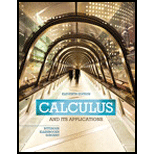
Concept explainers
Actuarial Science. An actuary works for an insurance company and calculates insurance premiums. Given an actual mortality rate (probability of death) for a given age, actuaries sometimes need to project future expected mortality rates of people of that age. For example,
where t is the number of years into the future and
projects future mortality rates.
a. Suppose the actual mortality rate of a group of females aged 25 is 0.014 (14 deaths per 1000). What is the future expected mortality rate of this group of females 3, 5, and 10 yr in the future?
b. Sketch the graph of the mortality function
for the group in part (a) for
Want to see the full answer?
Check out a sample textbook solution
Chapter 3 Solutions
Calculus and Its Applications (11th Edition)
Additional Math Textbook Solutions
Precalculus: Concepts Through Functions, A Unit Circle Approach to Trigonometry (4th Edition)
Calculus: Early Transcendentals (3rd Edition)
Thomas' Calculus: Early Transcendentals (14th Edition)
Calculus: Early Transcendentals (2nd Edition)
Single Variable Calculus: Early Transcendentals (2nd Edition) - Standalone book
- Is carbon dating? Why does it work? Give an example in which carbon dating would be useful.arrow_forwardPresent Value Present value is the amount of money that must be invested now at a given rate of interest to produce a given future value. For a one-year investment, the present value can be determined using PresentValue=FutureValue1+r, Where r is the yearly interest rate expressed as a decimal. Thus, if yearly interest rate is 8%, then 1+r=1.08. If an investment yields an yearly interest rate of 12% is available, what is the present value of an investment that will be worth 5000 at the end of 1 year? That is, how much must be invested today at 12% in order for the investment to have a value of 5000 at the end of a year?arrow_forwardAn investment account was opened with aninitial deposit of 9,600 and earns 7.4 interest,compounded continuously. How much will theaccount be worth after 15 years?arrow_forward
- Recall that the general form of a logistic equation for a population is given by P(t)=c1+aebt , such that the initial population at time t=0 is P(0)=P0. Show algebraically that cP(t)P(t)=cP0P0ebt .arrow_forwardWhat might a scatterplot of data points look like if it were best described by a logarithmic model?arrow_forwardQuestion 25 The population of deer in a certain area of Stanly county grows proportional to itself. The populat of deer in 2000 was found to be 145, and by 2010 the population had frown to 185. i. Find the growth constant k (rounded to 6 decimal places). k= ii. Find the expected number of deer in 2013 (rounded down to the nearest integer) Number of deer = iii. Find the rate of growth in 2015 (rounded to 3 decimal places) Rate of growth = deer per yeararrow_forward
- Suppose a man invested $250 at the end of 1900 in each of three funds that tracked the averages of stocks, bonds, and cash, respectively. Assuming that his investments grew at the rates given in the table to the right, approximately how much would each investment have been worth at the end of 2007? His investment in the fund tracking stocks would be worth approximately $. (Do not round until the final answer. Then round to two decimal places as needed.) Category Stocks Bonds Cash Average Annual Return 6.7% 2.4% 0.7%arrow_forwardSuppose a man invested $350 at the end of 1900 in each of three funds that tracked the averages of stocks, bonds, and cash, respectively. Assuming that his investments grew at the rates given in the table to the right, approximately how much would each investment have been worth at the end of 2009? His investment in the fund tracking stocks would be worth approximately $. (Do not round until the final answer. Then round to two decimal places as needed.) His investment in the fund tracking bonds would be worth approximately $. (Do not round until the final answer. Then round to tivo decimal places as needed.) His investment in the fund tracking cash would be worth approximately $ (Do not round until the final answer. Then round to two decimal places as needed.) Category Stocks Bonds Cash Average Annual Return 6.3% 1.7% 0.6%arrow_forwardThe population of the United States has grown at different rates over ten-year increments as shown by the following table. Year Population of U.S. 123.1 million 132.1 million 1930 1940 1950 152.3 million 1960 180.7 million If the maximum supportable population of the U.S. is 600 million people, use the logistic model to predict the population (in millions of people) of the U.S. in 2015 by using the following years as data points. (Round your answers to one decimal place.) (a) using 1930 and 1940 as data points 214.5 x million people (b) using 1950 and 1960 as data points 430.7 x million people Compare/contrast/explain the different results. The growth rate from part (a) is smaller than Ⓒ the growth rate from part (b).arrow_forward
 Functions and Change: A Modeling Approach to Coll...AlgebraISBN:9781337111348Author:Bruce Crauder, Benny Evans, Alan NoellPublisher:Cengage Learning
Functions and Change: A Modeling Approach to Coll...AlgebraISBN:9781337111348Author:Bruce Crauder, Benny Evans, Alan NoellPublisher:Cengage Learning Linear Algebra: A Modern IntroductionAlgebraISBN:9781285463247Author:David PoolePublisher:Cengage LearningAlgebra & Trigonometry with Analytic GeometryAlgebraISBN:9781133382119Author:SwokowskiPublisher:Cengage
Linear Algebra: A Modern IntroductionAlgebraISBN:9781285463247Author:David PoolePublisher:Cengage LearningAlgebra & Trigonometry with Analytic GeometryAlgebraISBN:9781133382119Author:SwokowskiPublisher:Cengage
 Glencoe Algebra 1, Student Edition, 9780079039897...AlgebraISBN:9780079039897Author:CarterPublisher:McGraw Hill
Glencoe Algebra 1, Student Edition, 9780079039897...AlgebraISBN:9780079039897Author:CarterPublisher:McGraw Hill




